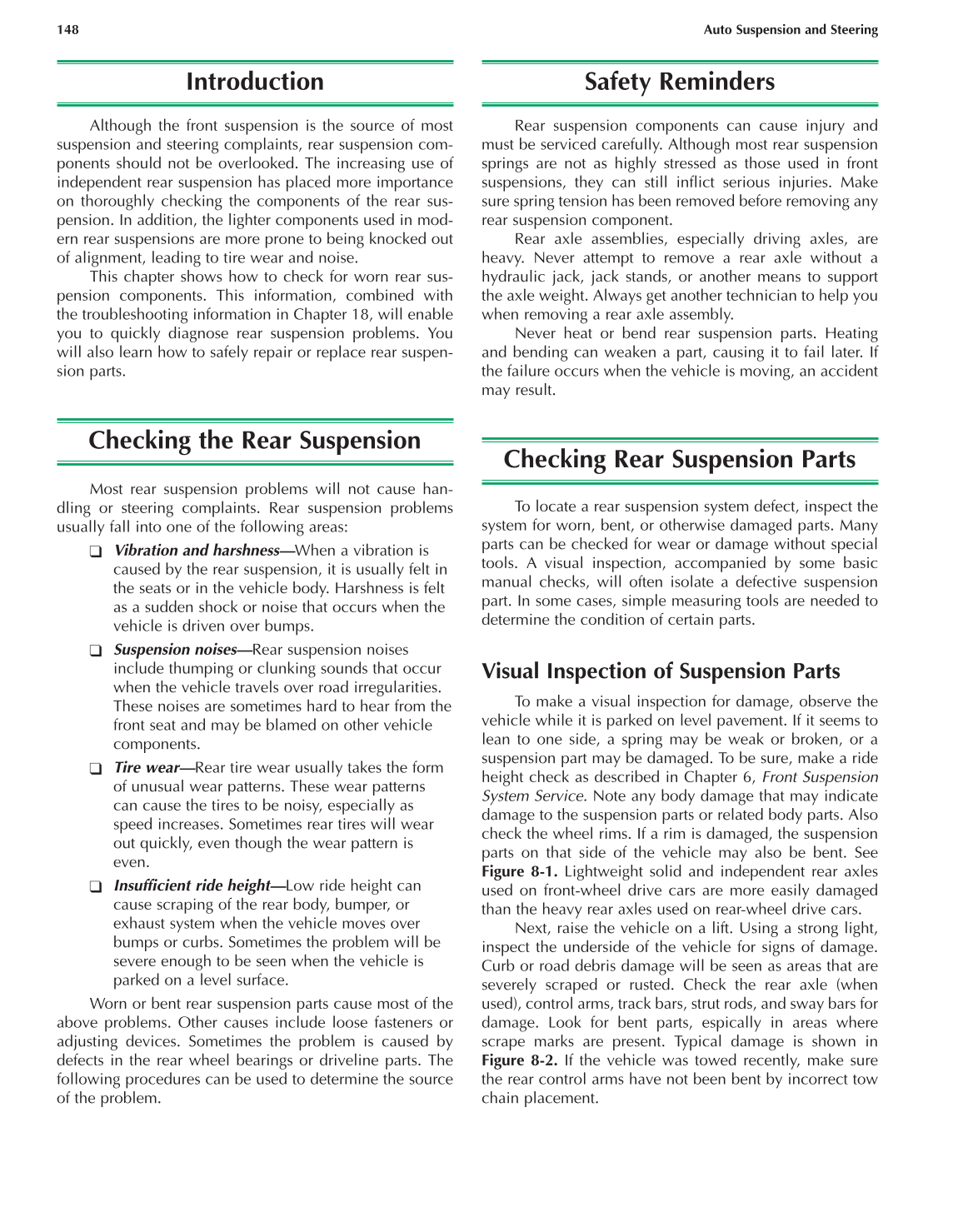148 Auto Suspension and Steering
Introduction
Although the front suspension is the source of most
suspension and steering complaints, rear suspension com-
ponents should not be overlooked. The increasing use of
independent rear suspension has placed more importance
on thoroughly checking the components of the rear sus-
pension. In addition, the lighter components used in mod-
ern rear suspensions are more prone to being knocked out
of alignment, leading to tire wear and noise.
This chapter shows how to check for worn rear sus-
pension components. This information, combined with
the troubleshooting information in Chapter 18, will enable
you to quickly diagnose rear suspension problems. You
will also learn how to safely repair or replace rear suspen-
sion parts.
Checking the Rear Suspension
Most rear suspension problems will not cause han-
dling or steering complaints. Rear suspension problems
usually fall into one of the following areas:
Vibration and harshness—When a vibration is
caused by the rear suspension, it is usually felt in
the seats or in the vehicle body. Harshness is felt
as a sudden shock or noise that occurs when the
vehicle is driven over bumps.
Suspension noises—Rear suspension noises
include thumping or clunking sounds that occur
when the vehicle travels over road irregularities.
These noises are sometimes hard to hear from the
front seat and may be blamed on other vehicle
components.
Tire wear—Rear tire wear usually takes the form
of unusual wear patterns. These wear patterns
can cause the tires to be noisy, especially as
speed increases. Sometimes rear tires will wear
out quickly, even though the wear pattern is
even.
Insufficient ride height—Low ride height can
cause scraping of the rear body, bumper, or
exhaust system when the vehicle moves over
bumps or curbs. Sometimes the problem will be
severe enough to be seen when the vehicle is
parked on a level surface.
Worn or bent rear suspension parts cause most of the
above problems. Other causes include loose fasteners or
adjusting devices. Sometimes the problem is caused by
defects in the rear wheel bearings or driveline parts. The
following procedures can be used to determine the source
of the problem.
Safety Reminders
Rear suspension components can cause injury and
must be serviced carefully. Although most rear suspension
springs are not as highly stressed as those used in front
suspensions, they can still inflict serious injuries. Make
sure spring tension has been removed before removing any
rear suspension component.
Rear axle assemblies, especially driving axles, are
heavy. Never attempt to remove a rear axle without a
hydraulic jack, jack stands, or another means to support
the axle weight. Always get another technician to help you
when removing a rear axle assembly.
Never heat or bend rear suspension parts. Heating
and bending can weaken a part, causing it to fail later. If
the failure occurs when the vehicle is moving, an accident
may result.
Checking Rear Suspension Parts
To locate a rear suspension system defect, inspect the
system for worn, bent, or otherwise damaged parts. Many
parts can be checked for wear or damage without special
tools. A visual inspection, accompanied by some basic
manual checks, will often isolate a defective suspension
part. In some cases, simple measuring tools are needed to
determine the condition of certain parts.
Visual Inspection of Suspension Parts
To make a visual inspection for damage, observe the
vehicle while it is parked on level pavement. If it seems to
lean to one side, a spring may be weak or broken, or a
suspension part may be damaged. To be sure, make a ride
height check as described in Chapter 6, Front Suspension
System Service. Note any body damage that may indicate
damage to the suspension parts or related body parts. Also
check the wheel rims. If a rim is damaged, the suspension
parts on that side of the vehicle may also be bent. See
Figure 8-1. Lightweight solid and independent rear axles
used on front-wheel drive cars are more easily damaged
than the heavy rear axles used on rear-wheel drive cars.
Next, raise the vehicle on a lift. Using a strong light,
inspect the underside of the vehicle for signs of damage.
Curb or road debris damage will be seen as areas that are
severely scraped or rusted. Check the rear axle (when
used), control arms, track bars, strut rods, and sway bars for
damage. Look for bent parts, espically in areas where
scrape marks are present. Typical damage is shown in
Figure 8-2. If the vehicle was towed recently, make sure
the rear control arms have not been bent by incorrect tow
chain placement.
